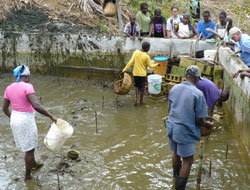 |
From Think Tank to Fish Tank
MBL hosts international experts at aquaculture symposium
April 17, 2008
 |
 |
Tilapia ready for market.
|
|
MBL, WOODS HOLE, MA—Aquaculture experts from around the world recently met at the MBL (Marine Biological Laboratory) to discuss their research, and how it may apply to fish farming in Haiti and in other third world nations.
The April 5 symposium, titled “Culturing Fish With Limited Resources,” was sponsored by the MBL’s Sustainable Aquaculture Initiative (SAI), and brought together scientists and fish culturists who share a common interest in improving fish culture using locally available resources.
For the last five years, MBL researchers, led by Bill Mebane, Superintendent of Marine Resources Aquaculture Engineering Division, have been developing fish-rearing tactics that can be used in Haiti and other developing nations to produce a reliable source of protein for their people. Their ultimate goal is finding a way to combat malnutrition.
 |
|
 |
Other Resources:
SAI Website
Photo Slideshow (quicktime)
Next Steps:
The aquaculture symposium group has developed three key points that they intend to refine into a formal statement. They are:
• Low-resource methods of food production are becoming increasingly important as the cost of living increases in developing countries, and as people put further demands on dwindling non-renewable resources.
• First world research institutions and local organizations in developing regions can work more effectively to solve issues that constrain low resource food production using social and economic incentives.
|
Armed with expertise in aquaculture engineering, fish husbandry, and fish physiology, Mebane and his colleagues developed a plant-based fish food that Haitian villagers could produce themselves using indigenous plants as the necessary protein base. The homemade food is a much-preferred alternative to commercial fish food, which is expensive, spoils in heat, and can be inconsistently available in the developing world.
Mebane and his team found that tilapia, a species of freshwater fish locally grown in small ponds, could be raised on the feed, but that the process of making the fish food was time consuming and the ingredients sometimes difficult to obtain. They needed a better method for feeding the fish.
More recently, the scientists have been exploring alternative techniques, including the promotion of periphyton growth, to feed the tilapia. Tilapia naturally graze on algae, bacteria, and small insects or zooplankton, all of which can be lumped into the category of periphyton. Periphyton, the slimy green coating found naturally on submerged surfaces, is the reason we slip when walking through a stream, and is a natural food source that contains all the needed fat, protein, and energy necessary for fish growth.
Four of the world’s leading experts in periphyton culture were present at the MBL symposium: Dr. Ana Milstein, of the Dor Fish & Aquaculture Research Station in Israel; Dr. Abdul Wahab, the head of the Department of Fisheries Management at Bangladesh Agricultural University; Dr. Barry Costa-Pierce, Director of Rhode Island Sea Grant and professor of Fisheries and Aquaculture University of Rhode Island; and Dr. Ron Zweig, an aquaculture specialist in the Environment and Natural Resources Division of The World Bank.
“These are the superstars in the field of periphyton culture and polyculture, but there is only so much you can do by email,” explains Mebane. “We hosted this meeting with the intention of learning, of engaging them in an intellectual partnership and collaboration.”
The methods Mebane and his colleagues have developed at the MBL have allowed Haitian fish farmers to encourage the growth of periphyton, using readily available resources such as palm leaves, banana leaves, and manure that were previously thrown away. While this method is not yet able to compete with fish production using commercial feeds, it is a way for people with limited resources to feed much needed protein to their families, or supplement their income. Fish production using these methods can yield harvests of 6,000 to 9,000 kilograms per hectare each year.
 |
 |
Harvesting the fish is a community exercise.
|
|
The SAI group recently traveled to Haiti to study the first full-cycle fish harvest using periphyton, and hopes to further refine their fish-farming techniques with the knowledge gained through this symposium. Haitian ponds harvested during the spring trip yielded significantly more fish than previous years; poundage that was produced with minimal labor in a sustainable fashion. SAI coordinator Nick Warren is encouraged by the results. “The test ponds yielded only about 50% of their maximum capacity, but all the fish were raised and harvested with locally available resources for free. We’ve proven that it can be done, now we need to expand it.”
“We’ve instructed them about what to put in the compost bins and trained them,” adds Mebane. “But it’s a day-by-day existence in these villages. Getting folks to keep up with the composting has been difficult. When people see the results that they can get with very little resources, then they are interested. It’s encouraging when you have people who want to get involved after seeing results.”
Mebane is hopeful that the knowledge gained at the symposium will help the SAI to achieve even greater results. “It’s possible,” says Mebane, “with the right pond techniques in low density fish culture systems, to get that same fish production using periphyton as using commercial foods.”
|
|
|
|
|
Harvesting tilapia from a pond in Haiti.
|
“I’m looking forward to next year’s harvest,” adds Warren. “One of our challenges has been the social realities of getting people to use these techniques. The symposium offered us not just technical information, but ideas on how to address the social obstacles.”
The MBL is a leading international, independent, nonprofit institution dedicated to discovery and to improving the human condition through creative research and education in the biological, biomedical and environmental sciences. Founded in 1888 as the Marine Biological Laboratory, the MBL is the oldest private marine laboratory in the Western Hemisphere. For more information, visit www.MBL.edu
|